More detail emerges about the Guelph Treasure lawsuit
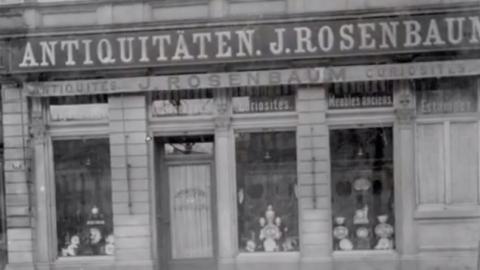
Frankfurt gallery of Guelph treasure dealers Rosenbaum and Rosenberg. (photo credit: YouTube screenshot)
An alert reader, alecti, discovered an aricle in the Berliner Morgenpost dated January 13, 2014 about the Welfenschatz (Guelph Treasure) lawsuit brought by twe Jews, Gerald Stiebel and Alan Philipp, against the German government. The article is titled "Who really owns the Guelf Treasure?"
Translating the article using Google Translate is far from perfect, but does give some clear ideas that I will use in this post. Anyone out there who can provide me with a better translation into English - please feel free to do so!
First, the dispute is officially between two heirs of the original Jewish art dealers and the SPK, the Prussian Cultural Heritage Foundation, which oversees the museums in Berlin. The collection of medieval reliquaries, alters, and crucifixes was kept for centuries in Prussia's Brunswick Cathedral. In the 17th century, approximately 80 items were removed from the cathedral by John Frederick, Duke of Brunswick-Luneburg.
In 1929, due to the Great Depression, the then Duke Ernest Augustus, by then only head of the House of Hanover, needed cash and sold the 80-piece collection to a Jewish consortium represented by art dealers Zacharias Max Hackenbroch, Issac Rosenbaum, Saemy Rosenberg, and Julius Falk Goldschmidt. These dealers took the collection to the United States, and in the next few years sold about half the collection. In 1934-35, the art dealers were still trying to sell the rest of the collection but there were no more buyers.
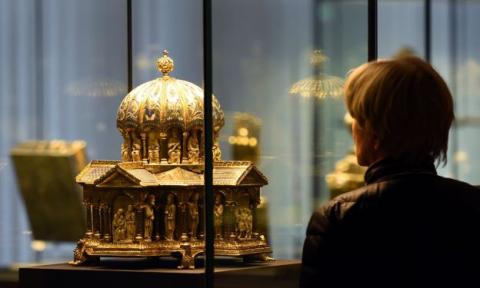
A visitor looks at the the cupola reliquary (Kuppelreliquar), the most expensive item in the ‘Welfenschatz’ (Guelph Treasure), displayed at the Kunstgewerbemuseum (Museum of Decorative Arts) in Berlin, on February 24, 2015
In Spring 1935 the 41-year-old Rosenberg begins negotiations with an unknown buyer via two representatives: Dresdner Bank Board member Samuel Ritscher and Berlin art dealer Alfons Heilbronner. Both are jews. For months Rosenberg and Heilbronner try to find a mutually acceptable price, while the collection is safely stored in a foreign vault beyond the reach of German authorities.
What was acceptable? As best I can understand the automatic translation, the consortium had paid 7.5 million Reichsmarks(RM) for the entire stock of 82 pieces in 1929. But it was a bad investment due to the economic crisis that followed from the October '29 Wall Street stock market crash. Plus, according to the sales contract, the consortium members were "not entitled to retain the items purchased in whole or in part, itself, but obliged to make every effort in order to make a sale."
In the second half of 1933, Germany began moving again. New self-confidence caused the mayor of Hanover to discuss buying the Guelph Treasure. Prussian Finance Minister Johannes Popitz eventually took over the coordination of such an endeavor.
In 1933, it was understood that one could "go down below the purchase price" if one "was seriously thinking of buying". It was clear that there were no other interested parties than the German authorities. Rosenberg's associate Hackenbroch, an experienced negotiator, assured an acquaintance in the Frankfurt Museum of Decorative Arts, "that the owners will meet in the price at any time" ... advising an "offer of five million Reichsmark."
On this news, Popitz mandated Dresdner Bank to get in touch with the consortium. They perfectly cast Samuel Ritscher who, by mid-1933, was the strong man of the Institute. Although Jewish, he officiated as "protected non-Aryans" continue on the Board and represent the Bank on numerous supervisory boards. It begins a tough tug of war. The main negotiator for the consortium is Rosenberg, who in 1934 transferred his art dealership to Amsterdam, with a branch in London. He asks for offers; the only price he could name was seven million Reichsmarks for the remaining 42 pieces of treasure - a too high amount, as is clear to everyone involved.
For months, there is no convergence, then a concession emerges: "Finally I could extract an offer at a lower base than those mentioned," writes Heilbronner on April 8, 1935 to Ritscher. Rosenberg had communicated (to Heilbronner), "that he is now able to make me an offer for the price of five million Reichsmark."
This was still too much for the buyers. Dresdner Bank instructed Prussian Finance Minister Popitz not to go beyond four million Reichsmark. Heilbronner came up with a counter-offer of 3.7 million RM, which Rosenberg rejected as too low. The minimum (he said) was 4.35 million RM "net cash"; he set a deadline of just ten days.
After further back and forth Popitz authorizes a specific amount: 4.1 million RM, not "net cash", but including the commission for Heilbronner of 100,000 RM. Rosenberg responds to this offer; he has achieved what he wanted: Within four weeks they had the contract of sale. The price eventually agreed upon was RM 4.25 million, including commission. On June 14, 1935 the agreement is signed; the Guelph Treasure is legally sold.
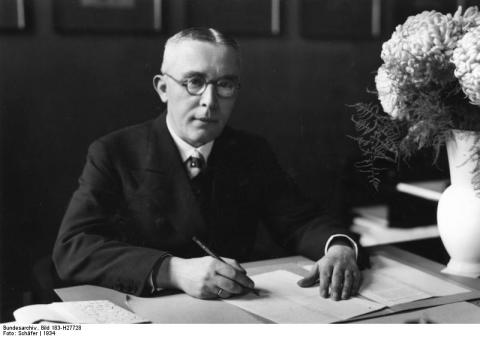
Prussian Finance Minister Johannes Popitz played a major role in the successful purchase of the Welfenschatz (Guelph Treasure).
Fast forward to December 1998. At a conference in Washington DC, the Federal Republic of Germany signs on to the "Washington Principles" which obligates it to return works of art that have allegedly been stolen by the "Nazis", or purchased under pressure at unreasonably low prices, to their rightful Jewish owners. However, it applies only to public art collections, especially the state museums. In case of challenge, museums must demonstrate "clean acquisition." For this there are three criteria: 1) Was the purchase price appropriate? 2) Did the seller receive the proceeds? 3) Was the money freely disposable?
As is common in such disputes concerning German art, the Guelph Treasure restitution claim went before Germany's Limbach Commission and in January 2014 the commission issued its findings that the transaction in 1935 was basically "clean." Members of the commission included Jutta Limbach, a former President of the Federal Constitutional Court, also former German President Richard von Weizsäcker and the historian Reinhard Rürup.
The purchase price: RM 4.35 million "net cash" is what Rosenberg offered on April 26, 1935. The final agreement was 4.25 million RM including the commission of 100,000 Reichsmarks, ie net 4.15 million RM, a reduction of just about 4.6 percent. This does not suggest a too low price agreed to under pressure.
Did the seller receive the proceeds? There are no receiver cash books but probably money orders. An invoice for 3.371 million RM was sent to Hackenbroch on 15 July 1935. A day later Popitz placed this payment, as well as the transfer of 678.125 RM into a blocked account.
A letter from the Dresdner Bank on 17 July 1935 confirms the payment to Hackenbroch, also a letter from the Frankfurter auditor August Herrgen of 22 September 1935, and a memo from February 1940.
Everything suggests that Hackenbroch paid the funds in the sum transferred to him to the consortium members.
Was the seller free to dispose of the money? There is hardly any information. Even today it is not known exactly how the consortium was composed. It is clear that Hackenbroch and Rosenberg in 1935 held 3.75 percent each; their colleague Julius Goldschmidt 2.5 percent. Mediator Heilbronner was involved with 2.5 percent.
There were apparently three people with a share of 25 percent. Of these, however, only one is known with certainty: the jeweler Hermann Netter, who ran a jewelry business in Frankfurt. You may also consider that the Frankfurt banker Willy Dreyfus was a member of the consortium. Certainly involved was Fritz Mannheimer, art collector and co-owner of the bank Mendelsohn & Co; He lived in Amsterdam.
The Prussian Cultural Heritage Foundation is in a difficult position. The demand for the Guelph Treasure is unfounded, at least according to current knowledge. A strong indication of this is that the Jewish Claims Conference has kept out of this restitution case
Bloomberg News, Oct. 8, 2013 tells us that the Jewish consortium paid RM 8 million for the entire collection in 1929:
The Prussian Cultural Heritage Foundation argues that the dealers got a fair price for the treasure and says the state of Prussia was the only interested buyer.
Including pieces sold in the preceding years, they earned 6.75 million Reichsmarks -- approximately 85 percent of the price they paid for it, the foundation says.
This works out to 8 million - 6.75 is 85% of about 8.
If the Prussian state paid over 4 million for only half of it in 1935, that would at least mean the Jews didn't sell that part at a loss. They recovered their cost and, in a time of deep economic depression, coming out even is not a loss! The Jewish lawsuit charges the Prussian buyers paid only " a fraction" of the market value, but it appears that "market value" was exactly what they paid. Of course, for Jews, who always want to make a killing, that's seen as a loss!
This article also mentions a "rival claim from the descendants of Hermann Netter, a Frankfurt jewelry dealer whose heirs say he owned 25 percent of the treasure."
And includes a statement from Alan Philipp, 70, calling him "the grandson of Zacharias Hackenbroch and a spokesman for the heirs of the four dealers." Philipp tries for sympathy by crying that his aunt and father recently died without seeing a positive result from their claim, even though they've been trying since 2008. Awwh.
The Jewish Telegraph Agency (JTA) writes on March 23, 2014 about an additional claimant — the heirs of the Jewish jeweler Hermann Netter, who reportedly owned 25 percent of the treasure at the time of its sale. They said they would continue their fight for restitution of the treasure. Dresden-based attorney Sabine Rudolph told the German news agency dpa that since the Netter heirs had been excluded from the previous deliberation, they would not recognize the commission’s decision. And:
A spokesperson for the Prussian Cultural Heritage Foundation told the online Sudkurier newspaper that Netter’s descendants had declined to make a claim together with the other heirs, and noted that the Limbach Commission’s rejection of the claim expressly included the descendants of other previous owners. But Rudolph said her clients had only just learned about the case in December.
It may be that the descendants of a 25% stakeholder don't want to be partners with those who only had a measly 3.75 or 2.50% share, yet initiated a restitution claim as the sole owners. We may see some Jewish infighting going on here if we keep a close eye on it.
Category
Art & Culture, Art News, Germany, Holocaust Industry Exposed, Jews- 487 reads







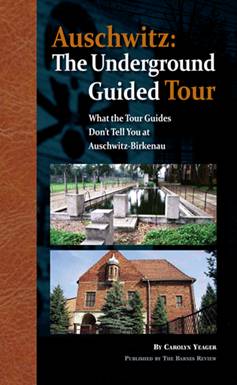

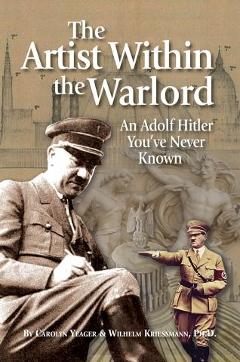
Comments
This could set a precedent....
It is very much appreciated that you have brought to our attention what is happening in Germany right now in the area of Jewish claims for restitution on treasures and continues to happen 80 years later. This really pushes my buttons! Thanks for summarizing further details and providing more of the facts surrounding what is considered the largest Jewish restitution claim. These Jewish distant relatives are trying to take away priceless cultural historic artifacts out of a German museum without sufficient documentary evidence to support their claim. If they get away with this it will set a precedent and open the flood gates for Jewish claims to loot entire German museums and the Churches of all what is left of priceless historic treasures without any documentary evidence.
The entire Jewish Consortium sounds very shady to begin with since they can't even provide the Consortium Agreement and have no idea how many members were actually involved in the deal. It seems like they can't even provide records as evidence to show what the Consortium did with the money after it was paid to them by the German bank. Meanwhile, the German government seems to have copies of the original sales agreement with Ernst August, the sales agreement of the sale to the German government in 1935, banking records, correspondence etc. Now after the Limbach Commission has prepared a report and did all the work digging through the records and providing documentary evidence. These US Lawyers are using the information in the Limbach report for their US Court Case. Do these lawyers not have any of their own reliable verifiable genuine documentary evidence to support their claim other than using generic Hollywood propaganda buzz words and a smear campaign in the public media to make the German government look bad?
The "smear campaign" is what I see
Lately, I've noticed an intensified number of news stories that have no purpose but to equate Germans as "Nazis," which is what the lawyers in the Guelph Treasure lawsuit are doing.
Bloomberg ran one recently: "Merkel's Germany feasts off of Europe," referring to its Eurozone dominance.
There's so much in the New York Times. Here's just one example, an editorial by a Jew Jacob Soll:
http://www.nytimes.com/2015/07/15/opinion/germanys-destructive-anger.html
And this one is really ugly:
http://www.vox.com/2015/7/16/8981765/merkel-refugee-failure-ashamed
Then there's this too, from "German" Jewish communists: https://www.youtube.com/watch?v=riQh4Qpvxm4
I have seen others, that Germans are "mean" and "heartless", the nazi lives in them and always will, so Germans must give, give, give, They owe it to Europe and Europe owes it to the world. It's incredibly SICK and Germans hardly have the ability to fight it. I think it's an attempt to destroy Germans forever. How about this:
http://sports.yahoo.com/news/europes-largest-jewish-sporting-event-coming-germany-121800917--spt.html
It makes you wonder why the Jews get away with having their own private Olympic games in Berlin when the "Nazis" invited the whole world in 1935!
David Rising is a Jewish AP writer. AP itself if Jewish! It's all Jewish and there is nothing else but Jews running the whole show. Every day some drummed-up story in the news about "holocaust" and "nazis". Jews are trying to take over Germany again. They're trying every which way to get Jews to move there permanently. The White mainstream enables it and that's why Jews are so successful -- the only reason. What chumps!